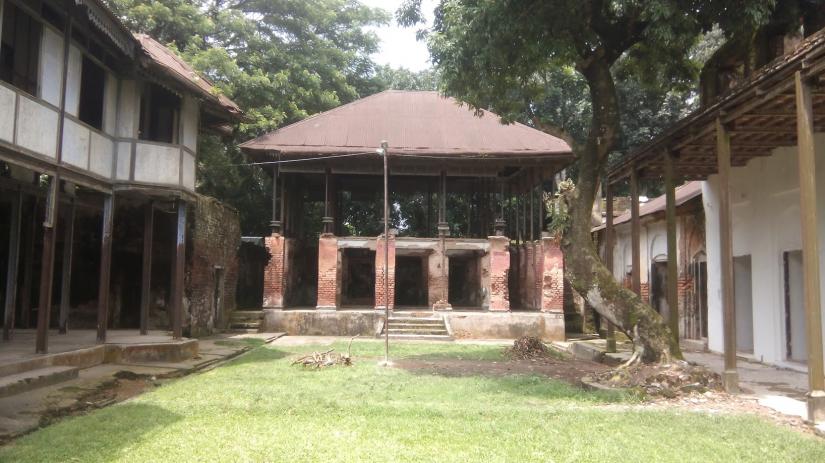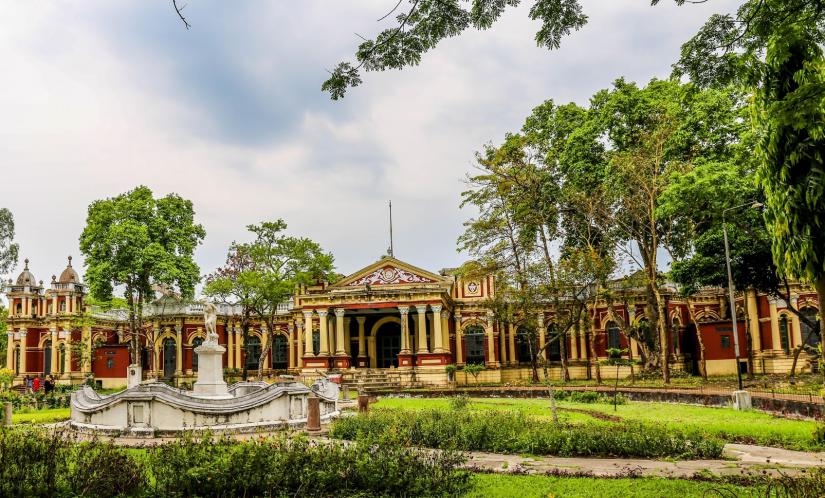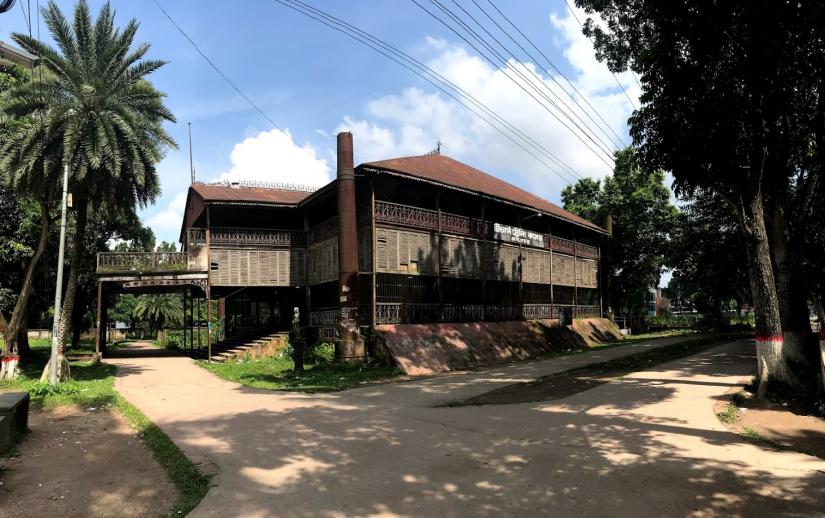The history of Mymensingh can be traced back to the sovereignty of Sultan Nusrat Shah (reigned between 1519-1532) who conquered the area from the Kamrupa Kings and thus the name Nasirabad came into being. In the period of Raja Todar Mal (the finance minister of emperor Akbar, died in 1589), Mymensingh was a rent-roll state in Sarkar Bazuha (Sarkar was an administrative unit in the Mughal Empire) and Jafar Shai Pargana in Ghoraghat, Dinajpur; which were part of the region granted to Isa Khan by Akbar. Unfortunately, the property slipped out of the hand of Isa Khan’s family after his death and was passed through various proprietor.
 In the end, Sri Krishna Chaudhury got the area as a grant from Nawab Alivardi Khan in 1727 and founded the Mymensingh Zamindari. His father Joy Narayan Talapatra was already a Zamindar in Bogra. He also received the Pargana of Taraf Karai and Tappe Hindi in 1710 from Murshid Quli Khan. The four grandsons of Narayan Talapatra, shifted their base from Bogra to Bahadurpur and then to Muktagacha. They constructed the Palace of Muktagacha and it is believed to be the part of ‘eight-anna’ Zamindari as the Raja Jagat Kishore Acharya acquired his and his second brother’s four-anna share (25%). Their younger brother, Maharaja Surya Kanta Acharya owned the other four-anna share (25%) but later expanded the Zamindari up to Sherpur, Susang, Dhaka, Malda, Faridpur, Murshidabad, Bogra and Pabna with his foresight. The noble man was awarded the title ‘Rai Bahadur’ in 1877, a ‘Raja’ in 1880 and a ‘Maharaja’ in 1897 for his generous nature and benevolent activities.
In the end, Sri Krishna Chaudhury got the area as a grant from Nawab Alivardi Khan in 1727 and founded the Mymensingh Zamindari. His father Joy Narayan Talapatra was already a Zamindar in Bogra. He also received the Pargana of Taraf Karai and Tappe Hindi in 1710 from Murshid Quli Khan. The four grandsons of Narayan Talapatra, shifted their base from Bogra to Bahadurpur and then to Muktagacha. They constructed the Palace of Muktagacha and it is believed to be the part of ‘eight-anna’ Zamindari as the Raja Jagat Kishore Acharya acquired his and his second brother’s four-anna share (25%). Their younger brother, Maharaja Surya Kanta Acharya owned the other four-anna share (25%) but later expanded the Zamindari up to Sherpur, Susang, Dhaka, Malda, Faridpur, Murshidabad, Bogra and Pabna with his foresight. The noble man was awarded the title ‘Rai Bahadur’ in 1877, a ‘Raja’ in 1880 and a ‘Maharaja’ in 1897 for his generous nature and benevolent activities.
He adopted Sashi Kanta Acharya, the son of his brother Raja Jagat Kishore Acharya. A magnificent building named ‘Shoshi Lodge’ was originally named after him. Another significant archaic pieces from this family is ‘Alexander Castle’ built by Shashi Kanta Acharya. Thus the whole Mymensingh district is actually enriched by this Zamindar family in many ways and this article is an effort to recollect some of them.
 Muktagacha Palace
Muktagacha Palace
An interesting story prevails about the name of Muktagacha. It is said that a local coppersmith named Muktaram presented a brass lamp stand to the eldest brother of the Acharya family. Then he became very pleased with the coppersmith. Later the Zamindar renamed ‘Bonodbari’ the hometown of worker as ‘Muktagacha’ in recognition of this beautiful gift and thus the palace of the landlord came to know as ‘Muktagacha Rajbari’ or ‘Muktagacha Palace’.
This splendid palace complex is situated about twelve mile west of Mymensingh Town and can be reached by a metalled road of fairly good condition. The abandoned compound comprises of several blocks, tanks and five temples. The formal entrance of this ten acre complex is from south with a grand frontage of about 100 feet long with a central arched gateway. A 50 feet long passageway from this gateway connects the courtyard to the entrance. A series of guard rooms are adjoined to this block.
The most imposing feature of the north block is a porch with a globular dome on raised square base. The entrance corridor leads to a long passage that opens under a semi-circular arch, carried on Corinthian columns, both singular and in pairs.
On the west, there is a ‘mandap’ block linked with a 50 feet square ‘nat-mandap’ covered by a high, round protuberant roof of corrugated iron supported on eight iron pillars. There is an elegant temple called Rajeswari Temple on its north with a spacious hall and veranda. The hall and the veranda has two rows of five semicircular arched openings, one behind another; supported on slender round columns with Corinthian capitals. The most beautiful feature of this ‘nat-mandapa’ is the revolving stage for theatrical performance, which is unfortunately a ruin now.
The residential apartments of the Raj, known as ‘Andar Mahal’ is behind this and arranged around a large open courtyard. It is a matter of great regret that, large portion of the palace of the ‘eight-anna sharers’ is damaged except a two-storied old wooden bungalow.
 Shashi Lodge
Shashi Lodge
Shashi Lodge or Mymensingh Rajbari is a late medieval marvel of Raja Jagat Kishore Acharya, who built and named the palace after his son Shashi Kanta Acharya on a parcel of nine acre land. The original royal palace was decorated by various precious items from parts of Europe. But that two storied building was completely destroyed in the earthquake of 1897 and later was rebuilt by Sashi Kanta himself in between 1905 and 1911 as a single storied structure.. The Palace is situated in the middle of the Mymensingh town with a grand river frontage of 150 feet and can be accessed through an impressive semi-circular arched gateway, flanked on either side with Doric columns. A large lawn composed with an ornamental marble fountain and a classical nymph sculpture lies between the palace and the gateway.
The symmetrical front facade of the edifice has three projecting porches, among which the central porch is the most prominent, with twelve elegant Corinthian columns allowing access to wheeled carriages underneath. The triangular pediment of the porch is adorned with beautiful floral scrolls in plaster above the parapet. A short ornamented wall is further added to enhance the elevation on either side of the central pediment. Two pairs of Corinthian columns, flanking on short staircases are part of the projecting bays on east and west end of the building. A huge ballroom, accessible directly from the central porch; one spacious hall from the east entrance and two large halls to the west of the ballroom are decorated by elaborate chandelier and marble flooring to serve as gathering places. All the doors and windows were beautifully adorned with the colorful glasses.
In addition to the building, is a two storied bathing pavilion or ‘Jol-tungi’ made of marble stone, only for ladies in the middle of a large pond. The Department of Archaeology (DOA) declared the monument as a protected monument in 1989 for its outstanding archaeological significance.
 Alexandar Castle
Alexandar Castle
Alexander Castle, better known as Lohar Kuthi is one of the most visited structures in the district. It was built by Maharaja Suryo Kanta Acharya Chowdhury in 1879 in the memory of the first zilla magistrate of Mymensingh, Mr. N. S. Alexander at the time of Jubilee festival taking a large area of 27.155 acres. Placed on the riverside, the whole building is established over a high plinth to avoid the flood water. The building has two Greek statues on both sides of the front gate, which still look great despite slight damages in their arms.
It is said that, the two storied structure was built with about 45,000 taka back then. Made by metals and woods on a high concrete base, the building was primarily used as a rest house for the guests of Maharaja Soshi Kanta Acharya Chowdhury. Many famous and renowned persons, Nobel Laureate poet Rabindranath Tagore, Lord Curzon, Chittaranjan Das, Nawab Sir Salimullah stayed in Alexander Castle while visiting the Mymensingh town. Poet Tagore arrived in the town on 15 February of 1926 and stayed in the Alexander Castle as a guest for four days. Mahatma Gandhi also stayed in this castle in the same year.
The house was lavishly decorated with expensive furniture and collectible items. There is a large open field in front of the castle and a garden with a pond behind. It is said that Maharaja used to keep his big cats in the garden in cages. At present the whole compound is used as a teachers training college (male) and the house is being used as its library.


